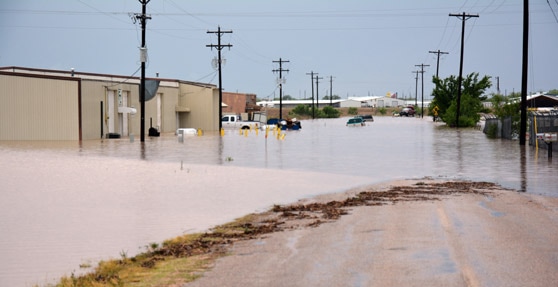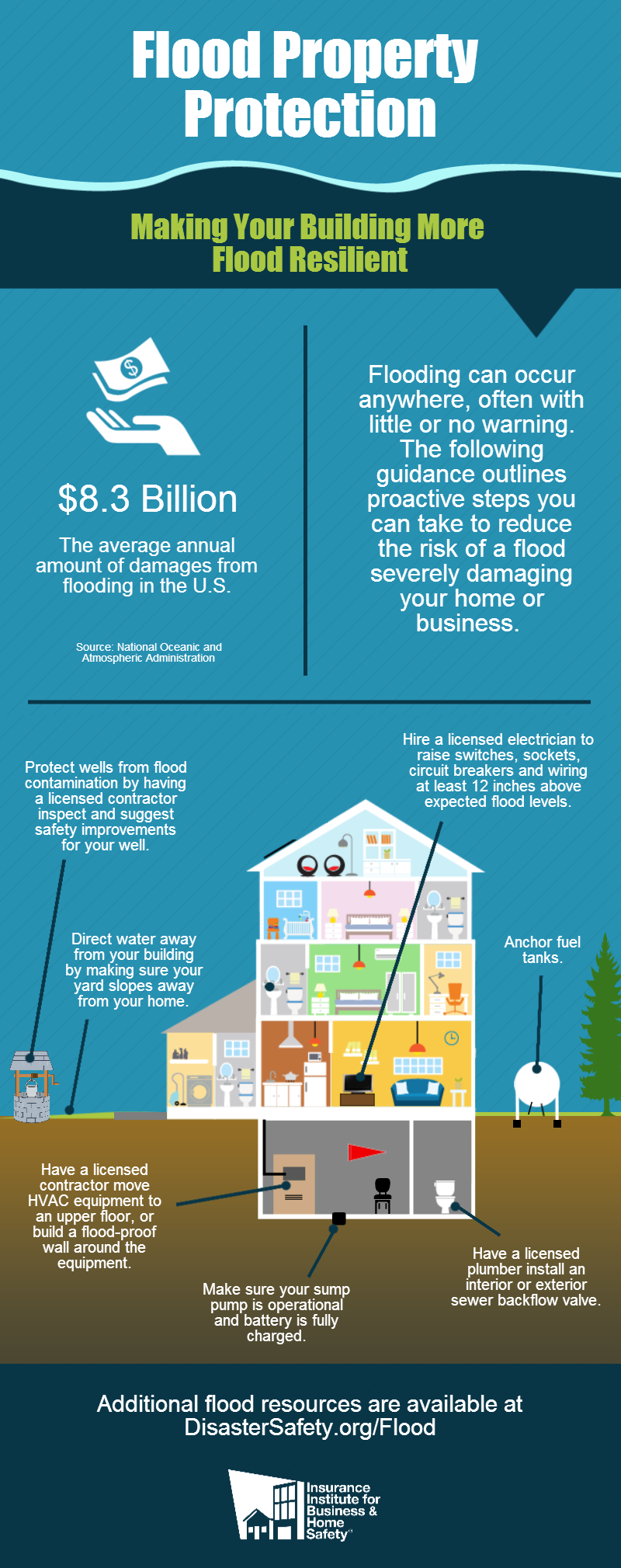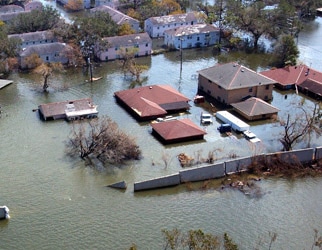|
After the flood waters recede and the clean up has been done, most folks want to get back into their homes or businesses and start rebuilding. The problem is that wood that has been submerged in water has likely absorbed a large amount of water. Rebuilding too quickly after a flood can cause continuing problems such as mold growth, insect infestations, and deterioration of the wood and wall coverings.
Flood waters are not clean water; therefore, most porous building materials must be removed and replaced with new materials. Caution!
1. Flood Insurance Claims If you have flood insurance, contact your insurance adjuster immediately.
Be sure all electric and gas services are turned off before entering the premises for the first time.
Until your local water company, utility, or public health department declares your water source safe, purify your water, not only for drinking and cooking, but also for washing any part of the body or dishes.
Remove all furniture, bedding, and carpeting to outdoors to be cleaned and dried (or discarded).
Open flooded walls, even if they appear undamaged, to prevent mold, odor, and structural decay later.
1. Subfloors
To reduce mold and damage, clean and dry as soon as flood waters recede. Do not sand or scrape lead-based paint.
Clean and dry the submerged household appliance before starting.
Take furniture outdoors to clean.
Aggressively control mold in the weeks and months after the flood.
Avoid disturbing and spreading mold spores indoors. Clean mildewed items outdoors. Learn and take precautions to minimize exposure to mold.
49 Comments
12/31/2021 03:25:45 pm
Rebuilding too quickly after a flood can cause continuing problems such as mold growth, insect infestations, and deterioration of the wood and wall coverings.
Reply
1/5/2022 01:50:17 pm
Flood waters are not clean water; therefore, most porous building materials must be removed and replaced with new materials.
Reply
2/1/2022 08:37:33 pm
Water damage can happen at any time and be very hard to fix on your own. Taking care of this issue as soon as possible will ensure that you do not experience any major problems. If you encounter a situation where water has seeped into your home and created structural and architectural damages, contact a water damage restoration company as soon as possible. They will come to assess the situation, clean up the mess, dry out your belongings, and make sure that your home smells fresh again. Keep writing these kinds of informative blogs. It's Appreciated.
Reply
2/9/2022 10:49:32 am
For quality water damage restoration services that are effective and affordable. We use cutting-edge technology and non-invasive hank you for the beautiful post!
Reply
2/18/2022 12:36:26 pm
Water damage restoration must be carried out as quickly and efficiently as possible following any sort of water ingress. Thank you for sharing your great post!
Reply
4/2/2022 11:27:10 am
If the subflooring is concrete, removal of the floor covering will hasten drying of the slab, but it might not be necessary if it would ruin an otherwise unharmed material. Thank you, amazing post!
Reply
4/15/2022 11:44:02 am
When floor coverings are removed, allow the subflooring to dry thoroughly, which may take months without a dehumidifier. Thank you for making this such an awesome post!
Reply
5/12/2022 08:58:35 am
To prevent mold from developing after water damage, you need a fast response from a professional water damage restoration contractor.
Reply
6/3/2022 11:58:38 am
Thank you for explaining that you'll need to remove all furniture, bedding, and carpeting to be cleaned, dried, or discarded. I've been wondering what sorts of steps we should take after our basement flooded. I'll be sure to remember this and get started on getting these items removed.
Reply
7/13/2022 12:51:24 pm
Enterprise Resource Management or ERM refers to software that allows business organizations to efficiently manage or administer user access to their network resources.
Reply
7/13/2022 01:04:20 pm
The best CRM for startups has the capability to deliver vital insights for informed sales decisions. The system pinpoints lead sources that drive maximum sales.
Reply
7/17/2022 10:07:30 pm
Clean out mud. Wall studs and plates may be sprayed with disinfectant (1 cup bleach/gallon water) to kill any existing mold and fungi. Tips are really helpful thanks for the sharing.
Reply
8/9/2022 03:57:21 pm
I appreciate you saying to take all furniture, bedding, and carpets outside to be washed and dried or thrown away. My uncle is doing his best to investigate alternatives to find a solution, especially after a flood in the region around his home, which is a flood plain. I'll send my uncle this post and advise him to hire water damage repair professionals to assist him with cleaning in the event of a flood in his home.
Reply
8/15/2022 07:43:10 am
You made a good point when you discussed that all circuits must be disconnected when dealing with a flood. My friend's house was damaged by the recent flooding. I should advise her to hire an expert in flood cleaning to prevent further damage.
Reply
8/25/2022 06:48:48 am
There was a lot of rain recently, and it ended up flooding my basement. It makes sense that I would want to work with a water damage specialist! It would be good to ensure that there isn't any damage done to my electrical systems.
Reply
9/7/2022 08:51:37 pm
I appreciate that you explained that you could start the cleaning by taking documentation of the problem to have ideas. The other week, my son and I experienced cleaning our home due to water damage because of a broken water system, it was a very frustrating experience. I love this instructive article, I'll be sure to consult a trusted water damage restoration service in the future as they can help us to prevent property damage.
Reply
9/30/2022 08:02:32 am
Last night, my aunt's house flooded due to a broken pipe while everyone was sleeping, and they didn't realize it until this morning. My aunt's going crazy with all the damage that the flood caused, so I think that she'll need to read your water damage guide. I appreciate your tips on protecting your home from developing mold after water damage.
Reply
10/4/2022 07:16:54 pm
Thank you for advising that water-logged carpets, rugs, and pads should be removed within 48 hours of the flooding ends. The flood is happening at my grandmother's house. I'll contact the water damage restoration business for her within 48 hours to clean up her home.
Reply
10/15/2022 07:07:27 am
Our water damage restoration cleaners arrive timely at the scene and inspect the impact of damage in affected areas. Thank you for sharing your great post!
Reply
10/15/2022 10:11:41 am
Solid wood, metal and plastic furniture may be cleaned and restored. Hose off any mud, clean, sanitize and let dry completely out of direct sunlight. Thank you for making this such an awesome post!
Reply
10/15/2022 11:26:30 am
The damage done by water can be extensive and is often irreversible. Water damage in your homes could be from pipe bursts, Thank you, amazing post!
Reply
10/17/2022 02:42:52 pm
If you’re looking for guidance or believe the damage is beyond what you can handle, it’s always a good idea to leave water damage restoration to the professionals, I’m so thankful for your helpful post!
Reply
I totally agree when you said that it is important to be safe from electrocution when there is flooding. Hopefully, all the sources of electricity will be shut down when there is flooding in any kind of property or location out there. Then, the owners can hire a residential, commercial, or industrial water damage restoration service safely to help them out with their belongings.
Reply
1/18/2023 11:37:38 pm
I love that you talked that one of the most destructive to wood properties is water. I remember when I experienced cleaning our home due to water damage. It was a very frustrating experience because I don't have anyone to help clean our home. Thanks to this informative article, I'll consult a trusted property damage restoration service in the future as they can help us to prevent property damage.
Reply
1/23/2023 09:26:32 am
Thank you for explaining that you should let the furniture dry outside slowly since it should help prevent warping. I've been wondering how to go about getting everything dry after finding our basement flooded. I'll be sure to try this out while we get all of the water damaged fixed professionally.
Reply
2/13/2023 01:24:37 pm
It stood out to me when you mentioned that it is important to aggressively control mold after a flood occurs in your home. It seems like the best way to aggressively combat mold growth is by hiring a water damage remediation service. This seems like a good idea because a remediation service will have equipment that will make water damage cleanup a breeze.
Reply
2/16/2023 01:46:42 pm
Until your local water company, utility, or public health department declares your water source safe, purify your water, not only for drinking and cooking, but also for washing any part of the body or dishes. I truly appreciate your great post!
Reply
2/27/2023 03:27:55 am
Nice post,We mainly work on property restoration but we also do home remodeling like bathroom remodeling and more!
Reply
3/22/2023 10:51:36 am
Thanks so much for talking about how carpets and rugs should always be replaced in case the flood water carried contaminants that are now in those materials. My cousins recently had their basement flood and they weren't sure how to start the restoration process so we've been trying to learn more about it. We'll have to look into hiring some professionals to help them with the project to ensure everything is cleaned up and discarded of properly.
Reply
3/24/2023 12:35:52 pm
I thought it was interesting when you mentioned that it is a good idea to wear rubber gloves when you are dealing with water damage in your home. I would think that it could be a good idea to temporarily turn off the power to your home if you have a significant amount of water. You would want to turn off the power so that you don't accidentally electrocute yourself while assessing the water damage.
Reply
4/6/2023 11:37:48 am
I didn't know that the carpet could shrink from water damage. Our basement was recently flooded. I'll have to make sure they check the carpet.
Reply
4/13/2023 10:55:51 pm
It really helped when you said that we should get the area dried as soon as possible when we have been flooded and save items that can be saved. I will tell this my neighbor after their basement has been filled with water after their pipes broke. And they can probably remove things that can still be fixed while they wait until tomorrow to hire a water restoration company to help them out, since it is late in the evening now.
Reply
5/5/2023 07:50:08 am
ADM Roofing Ltd is a highly-efficient, reliable roofing contractor providing first class roofing services in Glasgow, committed to putting you, the customer, first.
Reply
5/9/2023 04:57:49 am
If you are looking for builders in Stirling, Falkirk, Alloa and the surrounding regions, get in touch with the experts here at RB Joinery and Building Services Ltd
Reply
5/11/2023 10:38:01 am
It's good to know that you need to disconnect the main switch. Yesterday afternoon, a pipe burst in my basement causing it to flood, so my husband and I need to hire a professional to help us with fixing all of the damage it caused. We'll keep these tips in mind once we hire a water damage restoration company.
Reply
5/17/2023 06:37:46 pm
Dear Falmouth Flood Insurance,
Reply
5/21/2023 07:57:08 pm
Dear Falmouth Flood Insurance,
Reply
5/25/2023 03:55:47 am
Dear Falmouth Flood Insurance,
Reply
5/28/2023 06:51:46 pm
Thank you for sharing your informative blog post titled "Water Damage Restoration Clean-Up Checklist." As someone who understands the importance of being prepared for water damage incidents, I found your checklist to be a valuable resource for homeowners in Cape Cod and beyond.
Reply
5/29/2023 07:03:06 am
Thank you for sharing the information from the water damage restoration and cleanup checklist. It's important to emphasize that after a flood, proper drying and cleanup procedures are crucial to prevent potential issues like mold growth, insect infestations, and further deterioration of building materials.
Reply
5/29/2023 11:17:02 pm
Great article. Keep up the good work. If you are looking for professional services , Check Out
Reply
5/29/2023 11:38:01 pm
I recently came across your blog post titled "Water Damage Restoration Clean-Up Checklist" on your website, and I wanted to express my gratitude for sharing such a comprehensive and informative resource.
Reply
7/13/2023 06:13:35 am
This article provides crucial information on the steps to take after floodwaters recede, highlighting the potential risks of mold growth, insect infestations, and wood deterioration if not addressed properly. It emphasizes the importance of removing and replacing porous building materials that have been submerged. The article offers practical advice on safety precautions, insurance claims, electrical systems, and food and water sanitation. It also provides guidance on cleaning and drying furnishings and carpets, as well as when to discard or salvage certain items. Thank you for sharing this comprehensive and informative guide to post-flood cleanup.
Reply
7/22/2023 11:56:06 pm
Excellent article, We appreciate you providing us with this wonderful blog article. I will be using this tips for my own clients so that there dean mitchell group go smoothly.
Reply
9/16/2023 09:33:30 am
The issue is that wood that has been lowered in water has likely retained a lot of water. Revamping excessively fast after a flood can lead to proceeding with issues like shape development, bug pervasions, and crumbling of the wood and wall covers.
Reply
11/22/2023 10:15:44 am
Certainly! The provided content is a detailed water damage restoration checklist after a flood. It covers various aspects, including safety precautions, handling insurance claims, addressing electrical systems, ensuring food and water sanitation, managing furnishings and carpets, dealing with walls, and offering tips on preventing mold. The checklist emphasizes the importance of thorough and prompt actions to prevent long-term issues such as mold growth, insect infestations, and deterioration of materials. The checklist serves as a comprehensive guide for individuals dealing with the aftermath of water damage.
Reply
12/19/2023 06:00:36 pm
I love that you talked that sanitizing all the affected things could prevent mold growth. I remember when I experienced cleaning our home due to water damage. It was a very frustrating experience because I don't have the proper tools to clean our home. Thanks to this informative water safety tips article for the best planning approach. I'll consult a trusted water damage restoration service in the future as they can help us to prevent property damage.
Reply
Leave a Reply. |
Insurance InfoFor all the latest up to date insurance rates for Cape Cod, MA. CategoriesAll 5 Ways To Prevent Your Basement From Flooding Arbella Insurance Auto Insurance Bad Weather Driving Best Boat Insurance Best Car Insurance Best Insurance Best Policy Bourne Flood Insurance Bourne Home Insurance Buildings Buildings And Content Insurance Cape Cod Boat Cape Cod Flood Insurance Cape Cod Home Cape Cod Home Insurance Cape Cod Home Insurance Best Cape Cod Home Insurance Marthas Vineyard Insurance Falmouth Home Insurance Mashpee Home Insurance Cape Cod Home Insurance Falmouth Home Insurance Cape Cod Real Estate Cape Cod Home Insurance Falmouth Home Insurance Cape Cod Real Estate Universal Home Cape Cod Home Insurance Falmouth Home Insurance Cape Cod Real Estate Universal Home Universal Property Cape Cod Insurance Agency Home And Auto Insurance Car Insurance Car Owner Guides Centerville Home Insurance Home Insurance Agent Cape Cod Insurance Agent Cape Cod Insurance Agency Home And Auto Insurance Coastal Agents Alliance Community Outreach Contents Contents Insurance Dennis Home Insurance Yarmouth Home Insurance Vineyard Haven Home Insurance Nantucket Home Insurance Disability Safety Disaster Safety For People With Disabilities: What To Do When Emergency Weather Strikes Do I Need Flood Insurance Driver Safety Driving To Safety: The Car Owner's Guide To Emergency Evacuation Emergency Evacuation Emergency Evacuation Preparedness Falmouth Flood Insurance Falmouth Home Insurance FEMA Flood Program Flash Flood Safety: 5 Must Ask Questions Flash Flood Safety: 5 Must-Ask Questions Flood Flood Damage Flooding Flood Insurance Flood Insurance Costs Flood Insurance Rates FLOODS AND YOUR LIVESTOCK Guide Guide To Safe Driving Home Home And Car Insurance Home Insurance Home Insurance Agent Cape Cod Insurance Agent Cape Cod Insurance Agency Home And Auto Insurance Home Insurance Cape Cod Home Insurance Best Cape Cod Home Insurance Marthas Vineyard Insurance Falmouth Home Insurance Home Insurance Cape Cod Home Insurance Best Cape Cod Home Insurance Marthas Vineyard Insurance Falmouth Home Insurance Mashpee Home Insurance Sandwich Home Insurance Bourne Home Insurance North Falmouth Home Insurance Marion Home Insurance Household Insurance Information & Resources Insurance Insurance Emergency Strikes' Insurance Flood Insurance Policy Maps: Which Parts Of The U.S. See Flash Floods Most Often? Marion Home Insurance Plymouth Home Insurance Dennis Home Insurance Yarmouth Home Insurance Mashpee Flood Insurance Mashpee Home Insurance Mashpee Home Insurance Sandwich Home Insurance Bourne Home Insurance North Falmouth Home Insurance Narragansett Insurance National Flood Insurance Program Plymouth Home Insurance Dennis Home Insurance Yarmouth Home Insurance Vineyard Haven Home Insurance Nantucket Home Insurance Yarmouth Home Insurance Possessions Preparing For Vehicle Emergencies Prevent Flooding Replace Right Insurance Safe Driving Guides Safety Guide Safety Guides Tags: Safety Safety Insurance Sandwich Home Insurance Sandwich Home Insurance Bourne Home Insurance North Falmouth Home Insurance Marion Home Insurance Plymouth Home Insurance The Ultimate Guide To Hurricane Facts Universal Home Universal Property UPC Insurance MPIUA Mass Property Fair Plan Fair Plan Alternative Universal Insurance Universal Property UPC Insurance MPIUA Mass Property Fair Plan Fair Plan Alternative UPCIC Insurance UPC Insurance UPC Insurance MPIUA Mass Property Fair Plan Fair Plan Alternative Vehicle Emergency Kit Vehicle Safety Vineyard Haven Home Insurance Nantucket Home Insurance Yarmouth Home Insurance Centerville Home Insurance Water Damage Wind Vs. Hurricane Deductibles Wright Flood Yacht Insurance Yarmouth Home Insurance Centerville Home Insurance Home Insurance Agent Cape Cod Insurance Agent Archives
June 2021
|
-
HOME
- Cape Cod, MA - Send me a Home Quote
- Cape Cod, MA Home Insurance Protection
- Arbella Insurance Discounts
- Lloyds of London History
- Safety Insurance Discounts
- Cape Cod Massachusetts - Alternative to MPIUA - MA Property Insurance Underwriting Association "Fair Plan"
- Cape Cod Real Estate
- Hurricane Preparedness
- Hurricane Survival
- Hurricane Aftermath
- FLOOD
- Cape Cod Home Insurance
- AUTO
- BOAT
- BUSINESS
- LIFE
- OFFICES
- ABOUT US
- eServices
- Agent Login
- Contact Us
- Privacy Policy
-
HOME
- Cape Cod, MA - Send me a Home Quote
- Cape Cod, MA Home Insurance Protection
- Arbella Insurance Discounts
- Lloyds of London History
- Safety Insurance Discounts
- Cape Cod Massachusetts - Alternative to MPIUA - MA Property Insurance Underwriting Association "Fair Plan"
- Cape Cod Real Estate
- Hurricane Preparedness
- Hurricane Survival
- Hurricane Aftermath
- FLOOD
- Cape Cod Home Insurance
- AUTO
- BOAT
- BUSINESS
- LIFE
- OFFICES
- ABOUT US
- eServices
- Agent Login
- Contact Us
- Privacy Policy
Search by typing & pressing enter






 RSS Feed
RSS Feed
